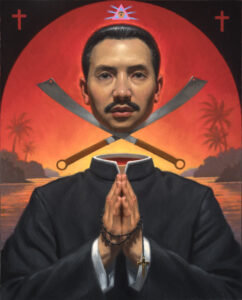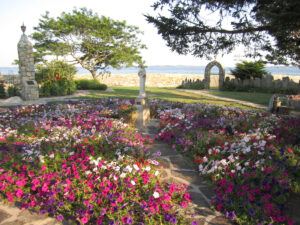I sat down with Benedict XVI Institute’s new composer-in-residence Frank La Rocca on a breezy San Francisco afternoon in late September to talk about the making of The Mass of the Americas.
The Mass of the Americas is many things:
It is the first new Mass commissioned for San Francisco’s Cathedral of St. Mary since the installation Mass in 1971.
It is written for mixed chorus, organ, string quartet, bells, and marimba.
The text of the Mass of the Americas is in Spanish, Latin, English and Nahuatl, the Aztec language in which Our Lady of Guadalupe spoke to San Juan Diego.
It is sacred music in the highest and best traditions of the Catholic Church, but it incorporates and elevates melodies from traditional Mexican hymns to Mary, especially La Guadalupana
The Mass of the Americas will be celebrated first at San Francisco’s St. Mary’s Cathedral on December 8, the Feast of the Immaculate Conception. This year December 8 falls on the Saturday before the Feast of Our Lady of Guadalupe. That means December 8 is also the day San Francisco Archdiocese hosts a large Our Lady of Guadalupe celebration, starting with a procession through the streets to the Cathedral plaza, replete with Marian statues, horses, Aztec dancers.
That is what gave Archbishop Salvatore Cordileone the ambitious idea: Why not commission a new Mass that honors Mary in both her forms? Why not create a new Mass that unites Anglo and Latino churches, popular hymns and sacred music? Why not create a Mass of the Americas that embodies the truth that Mary unites all of us as her children across diverse cultures?
In an age of cultural and liturgical silos, then, the Mass of the Americas is a creative breakthrough.
How did such a thing come to be? That’s what I asked the Benedict XVI Institute for Sacred Music and Divine Worship’s new composer-in-residence Frank La Rocca and this is what he told me.
“It was Archbishop Cordileone’s idea, totally,” Frank laughed. “The specific idea of a Mass of the Americas first came up at a Benedict XVI Institute board meeting. As we were talking over the idea of creating the composer-in-residence position, the Archbishop quipped ‘And the first composition is going to be a Mass of the Americas.’”
Frank paused, recalling that moment. “That did not surprise me. For as long as I’ve known him, almost ten years, cultural outreach through folk music in the context of the Mass has been a great interest of his.”
Archbishop Cordileone had once described to Frank weaving together music from the musical traditions of Africa, Asia, South and Central America, Europe, and the United States in a single Mass: a really musically universal Mass that touches all the tradition of the regions of the world.
How did you respond to the idea, I wondered?
Frank said, bluntly: “I told him, ‘That’s a very daunting challenge to create something like that.’”
“I’m not an ethnomusicologist,” Frank La Rocca explained to me, “I am a dyed-in-the-wool Western European classical composer. All of these things take me well outside the orbit of what I know.”
You think of yourself as a classical composer? I queried, not a sacred music composer?
“My musical language is Western European classical,” he responded firmly. “The whole western European classical music tradition is based on sacred music: Gregorian chant and polyphony. It’s all the same DNA.”
But despite La Rocca’s initial doubts, the Archbishop did not give up. “He brought it up when I saw him on other occasions,” Frank remembered, “‘I’d really like to have that multicultural Mass’ he kept telling me.”
It is the job of a composer-in-residence to respond to commissions. So once the Benedict XVI Institute brought him on board, and the Archbishop narrowed the musical focus from the whole world to the Mass of the Americas, Frank La Rocca got to work.
“He and I were both aware, in general terms, of the musical models used by missionary priests in Mexico, or later, California; they incorporated beloved popular tunes into the total experience of the Mass,” Frank said. One particular hymn the Archbishop himself suggested: La Guadalupana.
“The Archbishop said to me ‘you know that right?’” Frank rolled his eyes. “I said, um, no,” shaking his head at his own ignorance.
“Surely you must know Las Mananitas?” the Archbishop pressed on, “The Little Mornings”? Frank La Rocca again just shook his head. So, Frank La Rocca got to work researching: the Mission period, the music, the various versions of Mexican Marian folk hymns.
“La Mananitas is the Mexican equivalent of Happy Birthday, although originally the tune was created for a text about the Virgin Mary and King David, so it has a devotional history even though it’s not used that way now,” Frank told me, “La Guadalupana has always been, and it sounds like, a typical Mexican Mariachi tune: the oompah, oompah guitar, the crooning violins, and the two robust male singers. The challenge before me was to make the tune recognizable enough so anyone paying attention would sit up and say, ‘I know that’ but stripped of the sombreros, the guitars, the crooning violins and of course the words.”
He paused again, recalling the challenge. “That occupied a great deal of my time trying to figure out how close to the surface to bring the tune – how close to what listeners would be literally familiar with — in order for it to be recognized, and yet still get absorbed into the fabric of reverent music for the liturgy. There have been a great many arrangements of La Guadalupana. My challenge was to not worry about that at all, but to do the one that I thought was in a musical style appropriate to the tune while taking it to sacred places that, for all I know, no other arranger ever has.”
In some ways, it’s not that different than what many classical music composers have done over the centuries in incorporating folk tunes into the classical tradition. “That trend emerges strongly with German romanticism,” noted La Rocca who has a BA in music from Yale and his Ph.D. in from Berkeley, “Brahms has his Hungarian dances. Mozart did it. So did Schubert. It really took off towards the end of the 19th century when nationalist movements emerged: Bartok, Janacek, Liszt, Stravinsky, Honegger,” La Rocca ticked off a mental list. “Durufle picked up on the trend but instead of folk songs, he incorporated Gregorian chant. In America the premier example is Aaron Copland.”
Frank found both the words and the history these popular Mexican hymns to Mary particularly moving.
In the old Mission days, the experience of the Mass often began with the family gathering together in a family procession singing folk hymns right up to the vestibule of the Church before the Mass began.
Take Cantico Del Alba, “Song of the Dawn.”
“You might think, oh how nice. Mom and Dad and the kids walking along in their sandals singing a little tune,” said Frank. “Then you read the words: “Here comes the dawn, the breaking of the day, while we all proclaim Ave Maria. Maria was born as a consolation for sinners and to be the light of Heaven. Her birth was efficacious, she is full of grace…Hell trembled three times when we said the name of Maria. And we all sing in loud voices ‘Hail Mary, Mother of Grace.’”
Then there was the question of languages to be used. “The Archbishop and I discussed how this must be a multilingual mass in order to represent the Americas: Spanish, English, the language of the Church, Latin, Frank recalled. “I told the Archbishop I had an idea for using the Aztec language, Nahuatl. I had come across a translation of the Ave Maria in Nahuatl, and I wanted to translate that into some part of the Mass using the marimba, which was invented in South America. Unlike any of the other instruments in this Mass, it was invented in the New World by indigenous people.”
A marimba at Mass?
“The Archbishop came up with the idea of using that at the communion meditation—at a sort of parenthesis in the liturgical action. But there are ways of getting the marimba to sound that are unfamiliar to most people, a way that will fit right in, and that’s what I have done,” Frank responded.
The text that gave Frank the most trouble was his own fault: He is the one who suggested including Nahuatl: “When I googled Nahuatl translations of the Ave Maria there were ten or fifteen notably different versions that came up, differences big enough they could not be accounted for by shades of dialect. How am I going to find something genuine, authentic, authoritative?”
Frank started searching in scholarly works that touched upon the era of the missionaries in the 1500s and 1600s. That’s when he came across this book called, Confession, Large and Small, in the Mexican Language: 1634. It was written by Don Bartolome’ de Alva who turns out to have been a Catholic priest of mixed race.
“He knew both Spanish and Nahuatl. As a good pastor, he wanted to be sure his people knew what they were committing themselves to. So, he wrote a book in which he translates all of the teaching materials on the Sacrament of Confession as well as a number of the major prayers, e.g. what might be said as penance, from Spanish into Nahuatl. It’s out of print, but I was able to find a copy online from a used bookseller in Chicago,” Frank recalled, “It had exactly what I needed. If his translation of the prayer in 1634 — being a native speaker in both languages — isn’t authentic, I don’t know what is.”
If the aim of the Mass is to demonstrate the way Mary unifies all God’s children, what happens at the end of the Mass of the Americas is nothing short of a miracle. The Advent season’s recessional is Alma Redemptoris Mater. At the very end, as a punctuation to this grand Mass, Frank La Rocca added a short passage for organ and string quartet.
After the choir completes the singing of the hymn, the organ continues ‘singing’ the Alma Redemptoris Mater. Then the strings begin La Guadalupana.
And then for a brief glorious moment, they harmonize each other: wonderfully, hauntingly, gorgeously.
Come if you can December 8 to hear this miraculous Mass of the Americas. Or if you cannot come, it will be livestreamed and televised by EWTN. More information here.
Editors note: scroll down below to hear the Alma Redemptoris Mater harmonize with La Guadalupana




